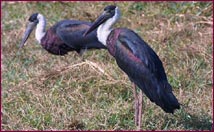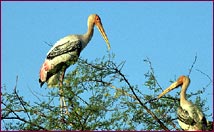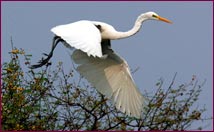These ponds attracted some unsuspecting migratory ducks and geese in the winter months, and so Suraj Mal decided to turn it into a permanent reservoir, the Arjun Bund. and soon, Bharatpur, Keoladeo Ghana Bird Sanctuary became one of India's most productive hunting reserves.
 The
16 square miles of marsh known as the Ghana jheel (ghana means
dense, and jheel lake) hosted such grand duck shoots that no serious
sportsman could afford to miss it. Colonel Sawai Brijendra Singh, a
later maharaja of Bharatpur, explains: "The jheel had islands
to which I constructed little roads that were wide enough for cars
to take VIPs out to their butts… Each duck shoot took months to
arrange and to see that VIPs were not given bad butts was like
making the seating arrangement for a dinner party. At the last
moment someone would say, "Sorry, I can't come", and you
then had to go through the list seeing who should go into a VIP butt
and who could have his place." Yet when it came to the largest
bags, even Bharatpur had to give way to the imperial sandgrouse
shoots at Bikaner.
The
16 square miles of marsh known as the Ghana jheel (ghana means
dense, and jheel lake) hosted such grand duck shoots that no serious
sportsman could afford to miss it. Colonel Sawai Brijendra Singh, a
later maharaja of Bharatpur, explains: "The jheel had islands
to which I constructed little roads that were wide enough for cars
to take VIPs out to their butts… Each duck shoot took months to
arrange and to see that VIPs were not given bad butts was like
making the seating arrangement for a dinner party. At the last
moment someone would say, "Sorry, I can't come", and you
then had to go through the list seeing who should go into a VIP butt
and who could have his place." Yet when it came to the largest
bags, even Bharatpur had to give way to the imperial sandgrouse
shoots at Bikaner. Flora & Fauna
 The
Keoladeo Ghana Bird Sanctuary is now home to more than 370 species
of birds. This large number comes somewhat as a surprise,
considering what went on earlier in the name of a game. The site has
gone through some of the worst events of duck shoots in the world.
In November 1938, the then Viceroy Lord Linlithgow and his party
massacred as many as 4273 ducks and geese. Linlithgow had with him
two loaders to help him reload, and his guns got so hot with the
rapid firing that they had to be sloshed regularly with cold water!
The
Keoladeo Ghana Bird Sanctuary is now home to more than 370 species
of birds. This large number comes somewhat as a surprise,
considering what went on earlier in the name of a game. The site has
gone through some of the worst events of duck shoots in the world.
In November 1938, the then Viceroy Lord Linlithgow and his party
massacred as many as 4273 ducks and geese. Linlithgow had with him
two loaders to help him reload, and his guns got so hot with the
rapid firing that they had to be sloshed regularly with cold water!During Springs The Keoladeo Ghana Bird Sanctuary Comes To Life
 Best
time to visit this bird sanctuary is during summers.The first shower
of the season makes the park come alive, teeming with hundreds of
feathered species. Cormorants, darters, spoonbills, ibises,
herons, egrets, cranes, pelicans, flamingos, geese, ducks, larks,
chats, kites, buntings, eagles, harriers, owls, vultures,
kingfishers and many more are the part of this vibrant wetland,
building nests in an estimated 50,000 trees. There are few places in
the world where such a variety of birds can be so easily observed.
Best
time to visit this bird sanctuary is during summers.The first shower
of the season makes the park come alive, teeming with hundreds of
feathered species. Cormorants, darters, spoonbills, ibises,
herons, egrets, cranes, pelicans, flamingos, geese, ducks, larks,
chats, kites, buntings, eagles, harriers, owls, vultures,
kingfishers and many more are the part of this vibrant wetland,
building nests in an estimated 50,000 trees. There are few places in
the world where such a variety of birds can be so easily observed.Visitors have claimed to have seen at least 80 species of birds among the 370 apart from some animals like the jackal, mongoose, sambar (large Asiatic deer), wild boar, turtles, monitor lizards within just half an hour of stepping into the park.





